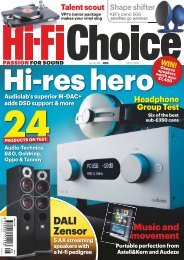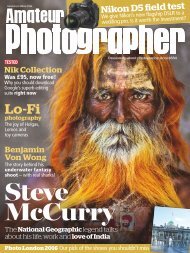You also want an ePaper? Increase the reach of your titles
YUMPU automatically turns print PDFs into web optimized ePapers that Google loves.
Each eyepiece has a high-quality rubber<br />
variable-height eye cup, which you adjust<br />
by twisting in and out. I found this mechanism<br />
both useful and easy to deal with.<br />
Also, the eyepiece barrels are hexagonal,<br />
thus ensuring an eyepiece will resist rolling<br />
when on its side. (I can’t count the<br />
times I have set an eyepiece down and<br />
watched it roll.) I tip my cap to Vixen for<br />
this design.<br />
Optically, these are seven-element eyepieces.<br />
Vixen notes that the units feature<br />
“high-transmission/low-dispersion lanthanum<br />
and exotic glass” with full multicoating<br />
on all lens surfaces and a special<br />
coating on the lens-connecting surfaces.<br />
The apparent field of view is 83°, which<br />
places it in the extra-wide category. Eye<br />
relief is a comfortable 13 millimeters.<br />
I tested the eyepieces on an 8-inch f/5.9<br />
Newtonian reflector (in which the eyepieces<br />
provided magnifications from 85x to<br />
340x) and a 4-inch f/7 apochromatic<br />
refractor (50x to 202x). Each eyepiece fit in<br />
the telescopes’ focusers with no problems;<br />
the reflector uses a set-screw to lock the<br />
eyepiece, whereas the refractor employs a<br />
compression ring to secure it.<br />
I used the complete SSW set to observe<br />
the Moon, the Orion Nebula (M42) — specifically<br />
the Trapezium — and Jupiter. My<br />
observing conditions over several nights<br />
remained excellent, with steady seeing and<br />
good transparency.<br />
Under the sky<br />
As a solar system observer and college<br />
astronomy professor, I always relish<br />
exploring the Moon. My first test was<br />
on a 62 percent illuminated waxing gibbous<br />
Moon. I usually like starting with<br />
the Moon on any telescope or eyepiece<br />
I am testing because it literally seems to<br />
“illuminate” any quality issues. I found no<br />
problems with any of the eyepieces.<br />
The 14mm SSW (I always start with the<br />
lowest magnification and increase) yielded<br />
an excellent image. Focusing was easy, and<br />
the image was sharp to the edge of the field<br />
of view. The terminator seemed to jump<br />
out at me in crisp, startling detail. As I progressed<br />
down to the 3.5mm eyepiece, I<br />
continued to enjoy superb views, although<br />
when I got to the 5mm and 3.5mm focal<br />
lengths, the views were not as crisp due to<br />
the weather conditions at my site.<br />
Some amateur astronomers like to<br />
employ a Barlow lens as a part of their<br />
observing routine. I like to see how effective<br />
the combination of a Barlow and eyepiece<br />
is versus an equivalent magnification<br />
As part of the author’s test of the SSW ED Ultra Wide Eyepiece line, he pointed several telescopes at<br />
the waxing gibbous Moon. He started by using the lowest-power eyepieces, and then increased the<br />
magnification. He concentrated his view along the terminator, where detail is greatest. JAMIE COOPER<br />
eyepiece, so I used a high-quality 2x<br />
Barlow lens with the eyepieces. I compared<br />
the 14mm eyepiece with the 2x Barlow to<br />
the 7mm eyepiece, and the 10mm with the<br />
2x Barlow to the 5mm eyepiece. The two<br />
eyepieces noticeably outperformed the<br />
eyepiece/2x Barlow combinations. I have<br />
not always found this to be the case. This<br />
test clearly demonstrates the quality of<br />
Vixen’s shorter-focal-length eyepieces.<br />
I also observed the Cold Winter Moon,<br />
as December’s Full Moon is called. I know<br />
most will think this is crazy (this phase of<br />
our satellite shows the least amount of<br />
detail), yet it allows me to see flaws in the<br />
optics. At higher magnifications — where<br />
the amount of light coming through an<br />
eyepiece is less than through lower powers<br />
— features on the Full Moon can look<br />
great. Through the 4-inch refractor, I<br />
PRODUCT INFORMATION<br />
Vixen SSW ED Ultra Wide<br />
Eyepieces<br />
Focal lengths: 3.5mm, 5mm, 7mm,<br />
10mm, and 14mm<br />
Size: 1¼"<br />
Eye relief: 13mm<br />
Apparent field of view: 83°<br />
Price: $349 each<br />
Contact: Vixen Optics<br />
1050 Calle Amanecer, Ste. C<br />
San Clemente, CA 92673<br />
[t] 949.429.6363<br />
[w] www.vixenoptics.com<br />
found the views both excellent and enjoyable,<br />
although the image the 14mm provided<br />
was a bit bright for me.<br />
The Orion Nebula can be a real test for<br />
optics, from the subtle patterns of its nebulosity<br />
to the faint point sources of the<br />
Trapezium, a tiny star cluster. I examined<br />
both carefully, and the eyepieces did not<br />
disappoint. The nebula’s delicate wisps<br />
were crisp at the set’s lower powers and not<br />
bad at the higher ones despite the softening<br />
sky conditions. I resolved the Trapezium<br />
easily at all magnifications and recorded in<br />
my observing notebook a view that was<br />
“quite delightful!”<br />
Jupiter was my final test. The jovian<br />
cloud belts appeared distinct, especially with<br />
low powers. I repeated my Barlow/non-<br />
Barlow comparison described earlier. I<br />
much preferred the non-Barlowed views; the<br />
images were noticeably sharper and brighter.<br />
Top marks<br />
If you’re in the market for a set of well-made<br />
and outstanding quality medium- to highmagnification<br />
eyepieces, I wholeheartedly<br />
recommend the new Vixen SSW ED Ultra<br />
Wide Eyepieces.<br />
My tests convinced me that these eyepieces<br />
deliver excellent images at all magnifications.<br />
You’ll enjoy high-magnification<br />
views of the Moon, planets, and nebulae,<br />
and take full advantage of your highquality<br />
telescope.<br />
Mike Reynolds is a contributing editor of<br />
<strong>Astronomy</strong>, a college professor, an author,<br />
and an equipment guru. He observes near<br />
Jacksonville Beach, Florida.<br />
WWW.ASTRONOMY.COM 65






